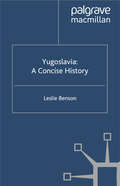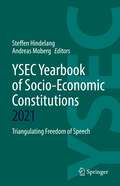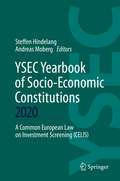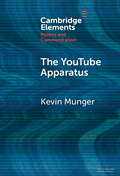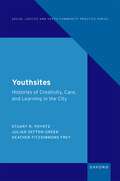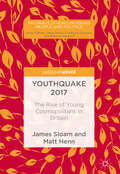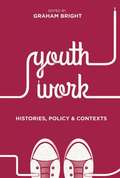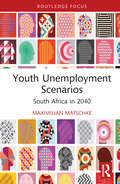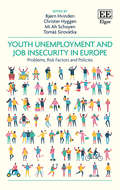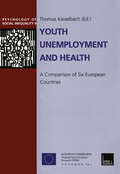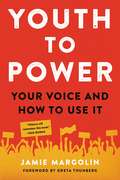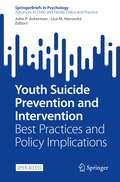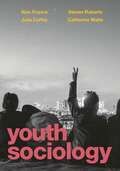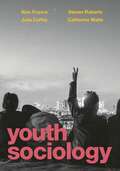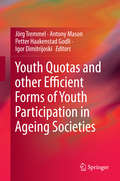- Table View
- List View
Yugoslavia and Macedonia Before Tito: Between Repression and Integration
by Nada BoskovskaHeld together by apparatchiks and, later, Tito's charisma, Yugoslavia never really incorporated separate Balkan nationalisms into the Pan-Slavic ideal. Macedonia - frequently ignored by Belgrade - had survived centuries of Turkish domination, Bulgarian invasion and Serbian assimilation before it became part of the Yugoslav project in the aftermath of the First World War. Drawing on an extensive analysis of archival material, private correspondence, and newspaper articles, Nada Boskovska provides an arresting account of the Macedonian experience of the interwar years, charting the growth of political consciousness and the often violent state-driven attempts to curb autonomy. Sketching the complex picture of nationalism within a multi-ethnic, but unitarist state through a comprehensive analysis of policy, economy, and education, Yugoslavia and Macedonia before Tito is the first book to describe the uneasy and often turbulent relationship between a Serbian-dominated government and an increasingly politically aware Macedonian people.Concerned with the question of integration and political manipulation, Boskovska gives credence to voices critical of Royal Yugoslavia and offers a fresh insight into domestic policy and the Macedonian question, going beyond traditional high politics. Broadening the spectrum of discussion and protest, she reveals the voices of a people protesting constitutional and electoral fraud, the neglect of local needs and state machinations designed to create a satellite province.
Yugoslavia and After: A Study in Fragmentation, Despair and Rebirth
by David A. Dyker Ivan VejvodaThis new book presents contributions by leading authorities on the origins of the Balkan crisis, the reasons for the decay and dissolution of the old Yugoslavia, the nature of the new regimes, the prospects for solution of the remaining conflicts and for the building of viable successor states.
Yugoslavia and After: A Study in Fragmentation, Despair and Rebirth
by David A. Dyker Ivan VejvodaThis new book presents contributions by leading authorities on the origins of the Balkan crisis, the reasons for the decay and dissolution of the old Yugoslavia, the nature of the new regimes, the prospects for solution of the remaining conflicts and for the building of viable successor states.
Yugoslavia: A Concise History
by L. BensonYugoslavia: A Concise History surveys the whole turbulent course of the country's history, in the context of the struggles between great powers for control of the Balkans. Torn apart by nationalist rivalries, the first Yugoslavia lapsed into paralysis and dictatorship. Axis occupation in 1941 unleashed a murderous civil war, in which the Communist Party emerged victorious. Tito's Yugoslavia appeared to the world as a peaceful, multi-national federation, but in the end disintegrated amid barbarism unknown in Europe for half a century. This revised and fully updated edition explains why, and takes the events up to the arrest of Milosevic in 2001and beyond.
Yugoslavia: When Ideals Collide (The Making of the Twentieth Century)
by Ann LaneYugoslavia was a phenomenon of the 'short' twentieth century. Its two incarnations fell between the cataclysm of the First World War which destroyed the old order, and the transformation of Europe which followed the collapse of communism in 1989. The task of building a viable, unified state was complicated not only by Yugoslavia's diverse cultural composition, but also by the pressures which the evolution of international society have placed on the modern state.Yugoslavia- explains and examines the key themes in the history of the former Yugoslavia- synthesises the main strands in contemporary debate about the origins of the Yugoslav crisis- presents a truly international history, exposing in full the role played by other countries in the rise and fall of the nation Focussing on both domestic and external factors, Ann Lane presents a balanced analysis of this ultimately failed attempt at state-building in a region of cultural diversity.
YSEC Yearbook of Socio-Economic Constitutions 2021: Triangulating Freedom of Speech (YSEC Yearbook of Socio-Economic Constitutions #2021)
by Steffen Hindelang Andreas MobergThis volume addresses contemporary challenges, enabled by modern technology, that concern upholding freedom of speech where it conflicts with social rights, such as respect for private and family life, and with economic rights, such as the freedom to conduct business or the right to free movement. In today’s networked world, technological shifts happen faster than most people even realize. Some of these shifts have made us all potentially powerful: media powerful. We used to sit in silence in front of newspapers and TV screens, and the world was explained to us by just a few sources. Today, thanks to the Internet, social media, and Web 2.0, we can not only share our own thoughts with everyone in a more self-determined way, but we can also take part in public debate and even co-shape it ourselves. Of course, the Internet is not a counter-design to the communication (power) structures of the past. Gains in communicative self-determination are threatened due to algorithmisation, platformisation, and value extraction from self-created private markets. At the same time, the empowerment of the individual challenges the old “grand speakers” who are suddenly detecting “fake news”, echo chambers, and filter bubbles everywhere on the Internet. Internet-based communication allegedly hinders us from the “one truth”; as if newspaper hoaxes, propaganda, and narrow-mindedness were an invention of the Internet. The current heated debate over “fake news”, copyright, and “upload filters” shows that we are unsure of how to deal with the newer and more complex phenomena of Internet-based speech. This is due in no small part to the fact that an important benchmark – our constitutional compass – is still firmly rooted in the past. Constitutions change far more slowly than technologies. Societal changes can drive constitutional changes; but what about normative content control? Today, there are already demands for “old-school clarity”: truth filters on social media platforms, horrendous sums of liability for platforms that encourage (overly)thorough cleaning up. However, it is equally true that private individuals “regulate”: they decide what is found on the Internet and who may post on a given platform. Accounting for all interests at play and striking a “fair” balance that avoids both a public and private over- and under-regulation is a complex matter. The authors of this volume not only provide reflections in their highly topical contributions, but also share their understanding of what constitutes a fair balance within the larger frame of freedom of speech in a digital age.
YSEC Yearbook of Socio-Economic Constitutions 2020: A Common European Law on Investment Screening (CELIS) (YSEC Yearbook of Socio-Economic Constitutions #2020)
by Steffen Hindelang Andreas MobergThis book presents the very first, interdisciplinarily grounded, comprehensive appraisal of a future “Common European Law on Investment Screening”. Thereby, it provides a foundation for a European administrative law framework for investment screening by setting out viable solutions and evaluating their pros and cons. Daimler, the harbour terminal in Zeebrugge, or Saxo Bank are only three recent examples of controversially discussed company takeovers in Europe. The “elephant in the room” is China and its “Belt and Road Initiative”. The political will in Europe is growing to more actively control investments flowing into the EU. The current regulatory initiatives raise several fundamental, constitutional and regulatory issues. Surprisingly, they have not been addressed in any depth so far. The book takes stock of the current rather fragmented regulatory approaches and combines contributions from leading international academics, practitioners, and policy makers in their respective fields. Due to the volume’s comprehensive approach, it is expected to influence the broader debate on the EU’s upcoming regulation of this matter. The book is addressed to participants from academia as well as to representatives from government, business, and civil society.
The YouTube Apparatus (Elements in Politics and Communication)
by null Kevin MungerThe academic agenda for studying social media and politics has been somewhat haphazard. Thanks to rapid technological change, a cascade of policy-relevant crises, and sheer scale, we do not have a coherent framework for deciding what questions to ask. This Element articulates such a framework by taking existing literature from media economics and sociology and applying it reflexively, to both the academic agenda and to the specific case of politics on YouTube: the Supply and Demand Framework. The key mechanism, traced over the past century, is the technology of audience measurement. The YouTube audience comes pre-rationalized in the form of Likes, Views and Comments, and is thus unavoidable for all actors involved. The phenomenon of 'radicalization' is best understood as a consequence of accelerated feedback between audiences and creators, radicalizing each other. I use fifteen years of supply and demand data from YouTube to demonstrate how different types of producers respond more or less to this feedback, which in turn structures the ideological distribution of content consumed on the platform. This title is also available as Open Access on Cambridge Core.
Youthsites: Histories of Creativity, Care, and Learning in the City (SOCIAL JUSTICE YOUTH COMMUNITY PRACTICE)
by Stuart R. Poyntz Julian Sefton-Green Heather Fitzsimmons FreyThis book is an original study of the youth organizations in London, Toronto, and Vancouver that offer creative and arts programs mainly to youth from diverse and socially marginalized backgrounds. It describes a sector that is often not recognized, organizations that don't like being institutionalized, forms of education that exist outside the mainstream, types of aesthetic expression that often go unrecognized, and unusual learning and cultural opportunities for socially marginalized young people. Rooted in the history of community arts movements from the 1970s, Youthsites, or the non-formal youth arts learning sector, is now part of cities around the world. Technological change, shifts in educational discourses, changes in policy rhetorics, including a turn away from traditional public institutions and a decline in funding of formal public schooling have all impacted the growth of youth arts organizations. Yet there are to date no systematic studies of the history, structure, and development of this sector. Youthsites: Histories of Creativity, Care, and Learning in the City fills this gap and is the first book to develop an internationally comparative, evidence-based, structural analysis of the development of the youth arts sector. Based on an original 4-year study examining the history, priorities, and tensions within this sector between 1995 and 2015, Youthsites explores the organizations and people who are helping young people to become creators, citizens, or just themselves in times of austerity, crisis, and change. This is an open access title available under the terms of a CC BY-NC-ND 4.0 license. It is free to read at Oxford Scholarship Online and offered as a free PDF download from OUP and selected open access locations.
Youthsites: Histories of Creativity, Care, and Learning in the City (SOCIAL JUSTICE YOUTH COMMUNITY PRACTICE)
by Stuart R. Poyntz Julian Sefton-Green Heather Fitzsimmons FreyThis book is an original study of the youth organizations in London, Toronto, and Vancouver that offer creative and arts programs mainly to youth from diverse and socially marginalized backgrounds. It describes a sector that is often not recognized, organizations that don't like being institutionalized, forms of education that exist outside the mainstream, types of aesthetic expression that often go unrecognized, and unusual learning and cultural opportunities for socially marginalized young people. Rooted in the history of community arts movements from the 1970s, Youthsites, or the non-formal youth arts learning sector, is now part of cities around the world. Technological change, shifts in educational discourses, changes in policy rhetorics, including a turn away from traditional public institutions and a decline in funding of formal public schooling have all impacted the growth of youth arts organizations. Yet there are to date no systematic studies of the history, structure, and development of this sector. Youthsites: Histories of Creativity, Care, and Learning in the City fills this gap and is the first book to develop an internationally comparative, evidence-based, structural analysis of the development of the youth arts sector. Based on an original 4-year study examining the history, priorities, and tensions within this sector between 1995 and 2015, Youthsites explores the organizations and people who are helping young people to become creators, citizens, or just themselves in times of austerity, crisis, and change. This is an open access title available under the terms of a CC BY-NC-ND 4.0 license. It is free to read at Oxford Scholarship Online and offered as a free PDF download from OUP and selected open access locations.
Youthquake 2017: The Rise of Young Cosmopolitans in Britain (Palgrave Studies in Young People and Politics)
by James Sloam Matt HennThis book is open access under a CC BY 4.0 license.This book investigates the reasons behind the 2017 youthquake – which saw the highest rate of youth turnout in a quarter of a century, and an unprecedented gap in youth support for Labour over the Conservative Party – from both a comparative and a theoretical perspective. It compares youth turnout and party allegiance over time and traces changes in youth political participation in the UK since the onset of the 2008 global financial crisis – from austerity, to the 2016 EU referendum, to the rise of Corbyn – up until the June 2017 General Election. The book identifies the rise of cosmopolitan values and left-leaning attitudes amongst Young Millennials, particularly students and young women. The situation in the UK is also contrasted with developments in youth participation in other established democracies, including the youthquakes inspired by Obama in the US (2008) and Trudeau in Canada (2015).
Youth Work, Galleries and the Politics of Partnership (New Directions in Cultural Policy Research)
by Nicola SimThis book sheds critical light on the routinely debated issue of how to create sustainable, equitable and meaningful partnerships between visual art organisations and youth organisations. Using a Bourdieusian framework, this book analyses the different social and professional worlds of youth work and gallery education and explores why tensions often arise between partners and young people in these fields. Written at a time of significant crisis for the UK youth sector and in the context of an entrenched neoliberal policy climate, this publication seeks to highlight hopeful, experimental practice and possibilities for creative resistance. With public organisations and services under ever-greater governmental pressure to pursue collaborations within and across sectors, this is a timely moment to examine the challenges, ethics and advantages of working together, and to bring theoretical discussion to dominant yet vague understandings of partnership.
Youth Work: Histories, Policy and Contexts (PDF)
by Graham BrightYouth work is a means of promoting learning, equality and inclusion with young people. It is an incredibly rewarding profession; however, diffuse state regulation means that youth work students and practitioners must continuously wrestle with the challenges of contemporary practice in environments that are complex and changing. This book brings together a collection of voices to speak to these concerns. Drawing on the history of the profession, each chapter focuses on a different aspect of policy and practice. Chapters explore the impact of New Labour; the changes that came with the coalition government; youth work in the voluntary sector, and youth work in a digital world. Graham Bright concludes with a powerful reflection on what the future holds for the profession. Each chapter features 'Over to You' activity boxes which invite readers to engage collaboratively in developing and applying ideas, with case studies which link discussion to real life examples. This is an important book for students, practitioners and lecturers in the field of youth and community work and related practice with children and young people.
Youth Unemployment Scenarios: South Africa in 2040 (Routledge Contemporary South Africa)
by Maximilian MatschkeThis book examines the factors driving youth unemployment in South Africa, exploring potential future outcomes of its mass unemployment, and offering a variety of strategies to avoid an impending crisis in the country. Utilizing scenario analysis rooted in complex systems theory while building on statistical and field research, the author illustrates four possible future states of youth employment in South Africa in the year 2040. This includes the South African version of the Arab Spring, where young people riot or agitate for extreme political and social change because of a belief that access to education and jobs is only possible through social status or corruption (Spring), fair access to a high number of jobs supported by Chinese interventions (Summer), a technology driven decline in the number of jobs where merit-based access for youth is granted (Fall), and the collapse of the economy, with the economy collapsing and youth becoming increasingly desperate (Winter). The author then presents five strategies to fight youth unemployment, including training of youth to start businesses, stimulating small and medium-sized enterprises, and sending unemployed youth abroad for skills development and to where their labour is in needed. This book will be of interest to scholars of South African politics and economics, labor economics and youth studies, and readers with an interest in tackling youth unemployment independent of the country.
Youth Unemployment Scenarios: South Africa in 2040 (Routledge Contemporary South Africa)
by Maximilian MatschkeThis book examines the factors driving youth unemployment in South Africa, exploring potential future outcomes of its mass unemployment, and offering a variety of strategies to avoid an impending crisis in the country. Utilizing scenario analysis rooted in complex systems theory while building on statistical and field research, the author illustrates four possible future states of youth employment in South Africa in the year 2040. This includes the South African version of the Arab Spring, where young people riot or agitate for extreme political and social change because of a belief that access to education and jobs is only possible through social status or corruption (Spring), fair access to a high number of jobs supported by Chinese interventions (Summer), a technology driven decline in the number of jobs where merit-based access for youth is granted (Fall), and the collapse of the economy, with the economy collapsing and youth becoming increasingly desperate (Winter). The author then presents five strategies to fight youth unemployment, including training of youth to start businesses, stimulating small and medium-sized enterprises, and sending unemployed youth abroad for skills development and to where their labour is in needed. This book will be of interest to scholars of South African politics and economics, labor economics and youth studies, and readers with an interest in tackling youth unemployment independent of the country.
Youth unemployment and social exclusion in Europe: A comparative study
by Torild HammerThis important new book presents the findings of the first comparative study of unemployed youth in Europe using a large and original data set. It addresses some of the key questions around the issue including: How do young people cope with unemployment? Does unemployment lead to social exclusion of young people, implying a withdrawal from society, financial deprivation and social isolation? Drawing on a research sample of over 17000 young unemployed people in ten European countries, the book examines how different welfare strategies and labour market policies in different countries influence the risk of social exclusion among unemployed youth.
Youth Unemployment and Job Insecurity in Europe: Problems, Risk Factors and Policies
by Bjørn Hvinden Christer Hyggen Mi A. Schoyen Tomáš SirovátkaProviding original insights into the factors causing early job insecurity in European countries, this book examines the short- and long-term consequences. It assesses public policies seeking to diminish the risks to young people facing prolonged job insecurity and reduce the severity of these impacts. Based on the findings of a major study of nine European countries, this book examines the diverse strategies that countries across the continent use to help young people overcome employment barriers. The authors present recommendations for governments to improve the job market environment and to support young people in finding suitable and stable employment. A vital tool for European policymakers, this book provides new knowledge that will help improve existing policies, at both national and European levels. The detailed analysis of original data collected through innovative methods will prove highly useful to public policy and European studies scholars.
Youth Unemployment and Health: A Comparison of Six European Countries (Psychologie sozialer Ungleichheit #9)
by Thomas KieselbachYouth unemployment has become one of the most crucial social problems in many EU countries. In the 90s it can be observed that in most Western countries, the rate of youth unemployment have risen dramatically, in some of these countries the unemployment problem can be considered primarily a problem of refused entry to the labour market for members of the younger generation. This development increases the risk of psychosocial impairment to the individuals affected as well as to the social fabric in general. The present volume draws attention to the health effects of long-term youth unemployment in six European countries. It is based upon the results of an international research project (Youth Unemployment and Social Exclusion: Dimensions, Subjective Experiences, and Innovative Institutional Responses in Six Countries of the EU) (YUSEDER) conducted in the framework of the research programme Targeted Socio-Economic Research (TSER) of the European Commission. Partners with different scientific backgrounds (health psychology, public health research, psychiatry, industrial sociology, medical sociology) from six European countries participated in this project. The contributions in this volume illustrate an initial approach to analysing and comparing empirical evidence on youth unemployment and health from a comparative perspective for three Northern European countries (Sweden, Germany, Belgium) and for three Southern European countries (Spain, Italy, Greece). For each country a specific national report is presented. The comparative section describes and attempts to explain the similarities and dissimilarities between countries having rather diverse historical and social understandings of being in and out of work for young people.
Youth to Power: Your Voice and How to Use It
by Jamie Margolin"Jamie Margolin is among the powerful and inspiring youth activists leading a movement to demand urgent action on the climate crisis. With determined purpose and moral clarity, Jamie is pushing political leaders to develop ambitious plans to confront this existential threat to humanity. Youth To Power is an essential how-to for anyone of any age who feels called to act to protect our planet for future generations." --- Former Vice President Al GoreClimate change activist and Zero Hour founder Jamie Margolin offers the essential guide to changemaking for young people.The 1963 Children's March. The 2016 Dakota Access Pipeline protests. March for Our Lives, and School Strike for Climate. What do all these social justice movements have in common?They were led by passionate, informed, engaged young people.Jamie Margolin has been organizing and protesting since she was fourteen years old. Now the co-leader of a global climate action movement, she knows better than most how powerful a young person can be. You don't have to be able to vote or hold positions of power to change the world.In Youth to Power, Jamie presents the essential guide to changemaking, with advice on writing and pitching op-eds, organizing successful events and peaceful protests, time management as a student activist, utilizing social and traditional media to spread a message, and sustaining long-term action. She features interviews with prominent young activists including Tokata Iron Eyes of the #NoDAPL movement and Nupol Kiazolu of the #BlackLivesMatter movement, who give guidance on handling backlash, keeping your mental health a priority, and how to avoid getting taken advantage of.Jamie walks readers through every step of what effective, healthy, intersectional activism looks like. Young people have a lot to say, and Youth to Power will give you the tools to raise your voice.
Youth Suicide Prevention and Intervention: Best Practices and Policy Implications (SpringerBriefs in Psychology)
by John P. Ackerman Lisa M. HorowitzThis open access book focuses on the public health crisis of youth suicide and provides a review of current research and prevention practices. It addresses important topics, including suicide epidemiology, suicide risk detection in school and medical settings, critical cultural considerations, and approaches to lethal means safety. This book offers cutting-edge research on emerging discoveries in the neurobiology of suicide, psychopharmacology, and machine learning. It focuses on upstream suicide prevention research methods and details how cost-effective approaches can mitigate youth suicide risk when implemented at a universal level. Chapters discuss critical areas for future research, including how to evaluate the effectiveness of suicide prevention and intervention efforts, increase access to mental health care, and overcome systemic barriers that undermine generalizability of prevention strategies. Finally, this book highlights what is currently working well in youth suicide prevention and, just as important, which areas require more attention and support. Key topics include: The neurobiology of suicide in at-risk children and adolescents.The role of machine learning in youth suicide prevention.Suicide prevention, intervention, and postvention in schools.Suicide risk screening and assessment in medical settings.Culturally informed risk assessment and suicide prevention efforts with minority youth.School mental health partnerships and telehealth models of care in rural communities.Suicide and self-harm prevention and interventions for LGBTQ+ youth.Risk factors associated with suicidal behavior in Black youth.Preventing suicide in youth with autism spectrum disorder (ASD) and intellectual disability (ID). Youth Suicide Prevention and Intervention is a must-have resource for policy makers and related professionals, graduate students, and researchers in child and school psychology, family studies, public health, social work, law/criminal justice, sociology, and all related disciplines.
Youth Substance Abuse: A Reference Handbook (Contemporary World Issues)
by David E. NewtonThis text provides readers with an in-depth understanding of the essential aspects of youth substance abuse—an important contemporary personal, social, and public health issue.Humans have been using natural and synthetic chemicals for at least two millennia—primarily for the purpose of treating medical problems, but also for recreational purposes. The 2014 Monitoring the Future survey of eighth, tenth, and twelfth grade students indicates a general decline in the use of illicit drugs over the last two decades. On the other hand, perceptions among youth that certain types of drug use—like marijuana and e-cigarettes—are harmless are growing. Youth Substance Abuse: A Reference Handbook provides an overview of the history and development of youth substance abuse along with a discussion of the medical, social, psychological, legal, and economic issues associated with youth substance abuse both in the United States and other parts of the world.The book begins with a comprehensive introduction to the subject of youth substance abuse that explains how modern societies have reached the point where abuse of both legal and illegal substances is a major health issue in many nations. Readers will learn about the effects of substances such as cocaine, marijuana, and heroin as well as substances that are typically legal but have deleterious health, social, or psychological effects, such as tobacco, alcohol, prescription drugs, and electronic cigarettes. Subsequent chapters address how and why youth substance abuse has become a problem in the United States and other countries, the demographics of this widespread problem, the direct and indirect effects of youth substance abuse and addiction, and the range of services and methods that are available for treating substance abuse.
Youth Substance Abuse: A Reference Handbook (Contemporary World Issues)
by David E. NewtonThis text provides readers with an in-depth understanding of the essential aspects of youth substance abuse—an important contemporary personal, social, and public health issue.Humans have been using natural and synthetic chemicals for at least two millennia—primarily for the purpose of treating medical problems, but also for recreational purposes. The 2014 Monitoring the Future survey of eighth, tenth, and twelfth grade students indicates a general decline in the use of illicit drugs over the last two decades. On the other hand, perceptions among youth that certain types of drug use—like marijuana and e-cigarettes—are harmless are growing. Youth Substance Abuse: A Reference Handbook provides an overview of the history and development of youth substance abuse along with a discussion of the medical, social, psychological, legal, and economic issues associated with youth substance abuse both in the United States and other parts of the world.The book begins with a comprehensive introduction to the subject of youth substance abuse that explains how modern societies have reached the point where abuse of both legal and illegal substances is a major health issue in many nations. Readers will learn about the effects of substances such as cocaine, marijuana, and heroin as well as substances that are typically legal but have deleterious health, social, or psychological effects, such as tobacco, alcohol, prescription drugs, and electronic cigarettes. Subsequent chapters address how and why youth substance abuse has become a problem in the United States and other countries, the demographics of this widespread problem, the direct and indirect effects of youth substance abuse and addiction, and the range of services and methods that are available for treating substance abuse.
Youth Sociology
by Julia Coffey Steven Roberts Alan France Catherine WaiteFalling somewhere between childhood and adulthood, ‘Youth’ is a key period of transition. It can be difficult to define and make sense of this period in one’s life. However it is categorised, young people face a number of challenges and issues growing up in today’s world. From the pressures created by social media to the increasing precarity of employment, the major social, cultural and economic developments of our time are each impacting this period of the lifecourse in myriad ways. Youth Sociology helps readers to understand how such changes factor into the experience of being young today, and illuminates the realities of the world in which young people live. Embedding perspectives and insights from a wide range of disciplines beyond sociology, this authoritative new textbook will be incredibly useful for all students of youth.
Youth Sociology
by Alan France Julia Coffey Steven Roberts Catherine WaiteFalling somewhere between childhood and adulthood, 'Youth' is a key period of transition. It can be difficult to define and make sense of this period in one's life.However it is categorised, young people face a number of challenges and issues growing up in today's world. From the pressures created by social media to the increasing precarity of employment, the major social, cultural and economic developments of our time are each impacting this period of the lifecourse in myriad ways. Youth Sociology helps readers to understand how such changes factor into the experience of being young today, and illuminates the realities of the world in which young people live.Embedding perspectives and insights from a wide range of disciplines beyond sociology, this authoritative new textbook will be incredibly useful for all students of youth.
Youth Quotas and other Efficient Forms of Youth Participation in Ageing Societies
by Jörg Tremmel Antony Mason Petter Haakenstad Godli Igor DimitrijoskiThis book examines ways to ensure that the rights, interests and concerns of young people are properly represented in Western democracies. One new proposal is the introduction of youth quotas in political institutions in order to counter the possible marginalization of young people caused by demographic ageing and, thereby, an overrepresentation of the interests of the elderly.The book explores key questions regarding the implementation of youth quotas from different perspectives, including philosophy, political science, sociology and demography. It examines whether youth quotas and other measures that give the young more voice and influence in political institutions are a good means for promoting the cause of intergenerational justice. In particular, it investigates how and if youth quotas can be used to ensure that the environmental interests of young and future generations are being taken into account.In addition, the book introduces an innovative model that would give a right to vote to minors without voting age boundaries. The book also discusses suffrage reforms through lowering the voting age in Western countries, as well as introducing methods especially aimed at raising the skills of children necessary for societal citizenship and empowerment of young citizens.The volume will help raise awareness and knowledge about the intergenerational implications of demographic changes in Western democracies, where ageing societies are increasingly turning into gerontocracies. It offers readers deep insight into how youth quotas in particular (and others forms of youth participation in general) might be efficient methods to ensure that younger generations are included in the political decision making process and other activities in society.


